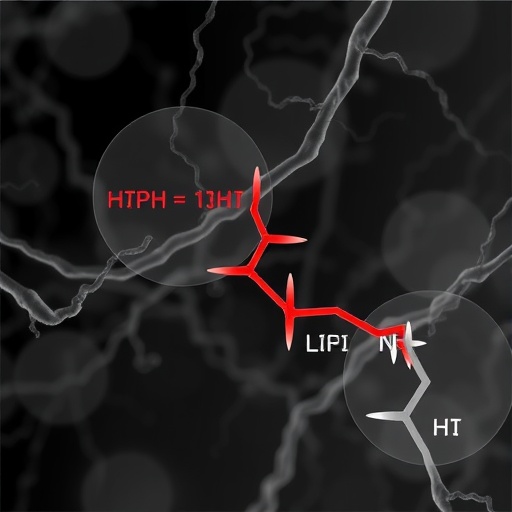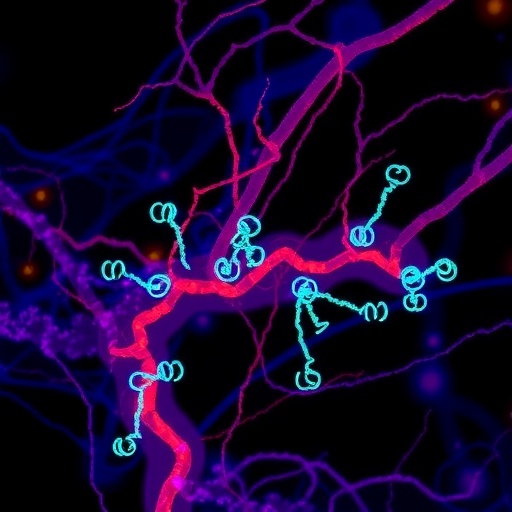
Recent advances in cardiovascular research have revealed critical insights into vascular biology, particularly focusing on a phenomenon known as intimal hyperplasia. This is a complex adaptive response that arises following arterial injury and can lead to significant complications such as restenosis, a condition wherein blood vessels narrow again after treatment. A groundbreaking study by Jiang and colleagues has illuminated the role of hydroxyindole O-methyltransferase (HIOMT) in modulating this pathological process, specifically through its smooth muscle-specific expression. The researchers provide compelling evidence that alterations in HIOMT levels can significantly influence the development of intimal hyperplasia, a finding that could reshape therapeutic strategies in vascular medicine.
The human body’s vascular system is a finely tuned network, designed to deliver oxygen and nutrients to tissues while efficiently removing waste products. However, when arteries sustain damage—whether from surgical interventions, atherosclerosis, or trauma—the healing process can sometimes lead to detrimental outcomes. Intimal hyperplasia is characterized by an abnormal proliferation of smooth muscle cells in the inner layer of the arterial wall, resulting in the thickening of this intimal layer. If left unchecked, this growth can lead to severe complications, including myocardial infarction or stroke.
Jiang et al. meticulously detail the mechanisms underlying HIOMT’s involvement in this pathological response. Hydroxyindole O-methyltransferase is an enzyme that catalyzes the transfer of a methyl group to hydroxyindole substrates, influencing various biochemical pathways. By specifically targeting smooth muscle cells, the expression of HIOMT appears to mitigate the onset and progression of intimal hyperplasia. This discovery is not just another piece of the vast puzzle that is vascular biology; instead, it represents a potential therapeutic target for clinicians and researchers alike.
In the laboratory components of the research, the team utilized a range of advanced techniques, including gene expression profiling and histological analysis. These methodologies allowed them to observe the intricate relationship between HIOMT levels and smooth muscle cell behavior following arterial injury. By employing both in vivo and in vitro models, they could validate their findings across different experimental systems. The data demonstrated that elevated expression of HIOMT correlated with reduced smooth muscle cell proliferation and migration, both critical processes in intimal hyperplasia.
Turning towards the clinical implications of their findings, Jiang and colleagues stress the importance of translational research. With a growing body of evidence supporting the role of HIOMT in vascular remodeling, the potential for developing therapeutic agents that mimic or enhance this enzyme’s activity could pave the way for innovative treatment options. Existing therapies often fall short, focusing primarily on controlling symptoms rather than addressing the underlying biological processes that drive intimal hyperplasia.
Importantly, the researchers emphasize that further studies are necessary to fully elucidate the role of HIOMT in different pathological contexts. Vascular diseases are inherently complex and influenced by a myriad of factors, including genetics, lifestyle, and the microenvironment of lesions. Understanding how HIOMT operates in conjunction with other signaling pathways could unveil novel intervention points, empowering the development of more efficient therapies.
Recent literature highlights that the immune response also plays a key role in intimal hyperplasia. As inflammation is a critical component of the healing response, its interactions with smooth muscle cells and the extracellular matrix warrant closer examination. Jiang et al. acknowledge how these broader biological interactions could influence HIOMT’s effectiveness in different patient populations. Thus, future investigations may integrate immunological perspectives alongside the study of enzymatic activities.
Moreover, this exciting research opens new avenues not only for therapeutic discovery but also for diagnostics. The relationship between HIOMT expression and intimal hyperplasia could be harnessed as a biomarker, allowing clinicians to better predict the risk of vascular complications in patients undergoing procedures such as angioplasty or stent placement. The integration of such biomarkers into clinical practice could ultimately lead to more personalized medicine approaches in cardiovascular care.
The implications of this research extend beyond arterial health. Hydroxyindole O-methyltransferase’s potential role in other diseases characterized by smooth muscle proliferation, such as pulmonary hypertension or certain malignancies, adds a layer of relevance to the findings. With the current trends in precision medicine, understanding enzymes like HIOMT could enhance our therapeutic toolkit across various domains of medicine, showcasing an interdisciplinary approach to treating complex diseases.
In conclusion, the work of Jiang and colleagues marks a significant milestone in vascular biology, particularly regarding the understanding of intimal hyperplasia. Their investigation into smooth muscle-specific expression of HIOMT lays the groundwork for future research aimed at curbing one of the most stubborn complications in cardiovascular interventions. As the field moves forward, integrating these findings into broader clinical practice might change not just how we manage arterial diseases but also how we approach vascular health in general.
The future of cardiovascular therapy may well depend on our ability to leverage such discoveries to improve patient outcomes and reduce the burden of vascular diseases, a challenge that continues to afflict millions worldwide. With innovative research like that of Jiang et al., the road ahead looks promising for patients at risk of intimal hyperplasia and its sequelae.
Subject of Research: Smooth muscle-specific expression of hydroxyindole O-methyltransferase and its role in arterial injury-induced intimal hyperplasia.
Article Title: Smooth muscle-specific expression of hydroxyindole O-methyltransferase reduces arterial injury-induced intimal hyperplasia.
Article References:
Jiang, WC., Chen, CH., Ho, HH. et al. Smooth muscle-specific expression of hydroxyindole O-methyltransferase reduces arterial injury-induced intimal hyperplasia.
J Biomed Sci 32, 78 (2025). https://doi.org/10.1186/s12929-025-01172-4
Image Credits: AI Generated
DOI: 10.1186/s12929-025-01172-4
Keywords: Hydroxyindole O-methyltransferase, intimal hyperplasia, smooth muscle cells, cardiovascular disease, vascular biology, enzyme expression.
Tags: adaptive responses to arterial damagecardiovascular research advancementscomplications of intimal hyperplasiaeffects of HIOMT on arterial healinghydroxyindole O-methyltransferase role in intimal hyperplasiamechanisms of smooth muscle cell proliferationmodulation of arterial wall thickeningmyocardial infarction risk factorsrestenosis after arterial treatmentstroke prevention in vascular healththerapeutic strategies for vascular medicinevascular biology and arterial injury




